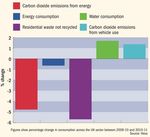Easier being green when there's a bottom-line gain
14th June 2012
Academy is making strides on sustainability, but water use is on the rise
The sector is getting greener on a number of measures - except for water consumption, where there is limited financial imperative to cut down on use.
That is the finding of a Times Higher Education analysis of environmental figures for UK universities, taken from the latest estates data released by the Higher Education Statistics Agency.
Institutions emitted less carbon dioxide, recycled more waste and audited their environmental impact more in 2010-11, according to the figures.
Carbon dioxide emissions from energy use across the UK were down from 2.62 million tonnes to 2.5 million tonnes, and English institutions look on track to hit a funding council target to reduce emissions by 43 per cent by 2020.
The Higher Education Funding Council for England has challenged the sector to slash its carbon output from a 2005 baseline of 2.06 million tonnes, including vehicle emissions as well as energy use.
Although the latest Hesa figures are not from the same data set, it shows that the English higher education sector produced 2.02 million tonnes in 2010-11.
This is 136,299 fewer tonnes than the previous year. If the sector keeps up this annual reduction over the next decade, it would hit Hefce's target around 2016.
Jules Pretty, pro vice-chancellor for sustainability and resources at the University of Essex, said that while the 43 per cent target should be "possible" for the sector to achieve, universities would still be able to expand.
He said: "Every new building has to be at least carbon neutral for it not to add to the total."
However, it seems the sector is being strongly motivated by the need to save money as well as green credentials.
"Energy costs have gone up so dramatically" that "there's no better way to make money [by cutting energy use]...if you have got the capital in the first place", Professor Pretty said.
He said the introduction of a combined heat and power plant at Essex would allow the university to achieve the Hefce target at a stroke.
A fall in carbon emissions across the UK has been mirrored by a small drop in the amount of energy universities are using.
Mark Cleverly, head of higher education at the building consultancy EC Harris, said that universities were investing in low-energy lighting and refitting existing buildings but this required a "sizeable investment" in a "tough time".
"It seems to me that they are making progress but not as fast as they might like in this time of austerity," he said.
The government charges organisations £64 to dispose of a tonne of waste that can decay or contaminate land. Professor Pretty said this tax, which has steadily been going up since 1996, had also forced universities to send less to landfill.
Recycling was also "the sort of thing that people can see they can do something about" environmentally, he said.
In contrast, there was "a major concern [over water] with all the droughts" but no major economic incentive to cut consumption, he said, and it was hard to see that universities would change behaviour unless one was introduced.
Written by David Matthews,
[email protected]
Read full article







 Except where otherwise stated, content on this site is
licensed under a Creative Commons Attribution 3.0 License.
Except where otherwise stated, content on this site is
licensed under a Creative Commons Attribution 3.0 License.
